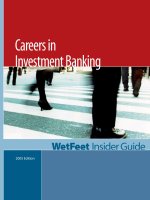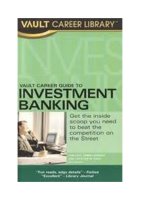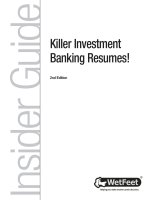Investment banking 2e by joshua rosenbaum
Bạn đang xem bản rút gọn của tài liệu. Xem và tải ngay bản đầy đủ của tài liệu tại đây (22.5 MB, 653 trang )
Contents
Cover
Series
Title Page
Copyright
Dedication
Additional Resources
VALUATION MODELS
WORKBOOK
FOCUS NOTES
About the Authors
CONTACT THE AUTHORS
Foreword
Acknowledgments
Introduction
STRUCTURE OF THE BOOK
VALUECO SUMMARY FINANCIAL INFORMATION
2
Part One: Valuation
Chapter 1: Comparable Companies Analysis
SUMMARY
OF
ANALYSIS STEPS
COMPARABLE
COMPANIES
STEP I. SELECT THE UNIVERSE OF COMPARABLE
COMPANIES
STEP II. LOCATE THE NECESSARY FINANCIAL
INFORMATION
STEP III. SPREAD KEY STATISTICS, RATIOS, AND
TRADING MULTIPLES
STEP
IV.
BENCHMARK
COMPANIES
THE
COMPARABLE
STEP V. DETERMINE VALUATION
KEY PROS AND CONS
ILLUSTRATIVE
COMPARABLE
ANALYSIS FOR VALUECO
COMPANIES
Chapter 2: Precedent Transactions Analysis
SUMMARY
OF
ANALYSIS STEPS
PRECEDENT
TRANSACTIONS
STEP I. SELECT THE UNIVERSE OF COMPARABLE
ACQUISITIONS
3
STEP II. LOCATE THE NECESSARY DEAL-RELATED
AND FINANCIAL INFORMATION
STEP III. SPREAD KEY STATISTICS, RATIOS, AND
TRANSACTION MULTIPLES
STEP
IV.
BENCHMARK
ACQUISITIONS
THE
COMPARABLE
STEP V. DETERMINE VALUATION
KEY PROS AND CONS
ILLUSTRATIVE
PRECEDENT
ANALYSIS FOR VALUECO
TRANSACTION
Chapter 3: Discounted Cash Flow Analysis
STEP I. STUDY THE TARGET AND DETERMINE KEY
PERFORMANCE DRIVERS
STEP II. PROJECT FREE CASH FLOW
STEP III. CALCULATE WEIGHTED AVERAGE COST OF
CAPITAL
STEP IV. DETERMINE TERMINAL VALUE
STEP V. CALCULATE PRESENT
DETERMINE VALUATION
KEY PROS AND CONS
4
VALUE
AND
ILLUSTRATIVE DISCOUNTED CASH FLOW ANALYSIS
FOR VALUECO
Part Two: Leveraged Buyouts
Chapter 4: Leveraged Buyouts
KEY PARTICIPANTS
CHARACTERISTICS OF A STRONG LBO CANDIDATE
ECONOMICS of LBOs
PRIMARY EXIT/MONETIZATION STRATEGIES
LBO FINANCING: STRUCTURE
LBO FINANCING: PRIMARY SOURCES
LBO FINANCING: SELECTED KEY TERMS
LBO
FINANCING:
STRUCTURE
DETERMINING
FINANCING
Chapter 5: LBO Analysis
STEP I. LOCATE AND ANALYZE THE NECESSARY
INFORMATION
STEP II. BUILD THE PRE-LBO MODEL
STEP III. INPUT TRANSACTION STRUCTURE
STEP IV. COMPLETE THE POST-LBO MODEL
5
STEP V. PERFORM LBO ANALYSIS
ILLUSTRATIVE LBO ANALYSIS FOR VALUECO
Part Three: Mergers & Acquisitions
Chapter 6: Sell-Side M&A
AUCTIONS
NEGOTIATED SALE
Chapter 7: Buy-Side M&A
BUYER MOTIVATION
ACQUISITION STRATEGIES
FORM OF FINANCING
DEAL STRUCTURE
BUY-SIDE VALUATION
MERGER CONSEQUENCES ANALYSIS
ILLUSTRATIVE MERGER CONSEQUENCES ANALYSIS
FOR THE BUYERCO / VALUECO TRANSACTION
Afterword
Bibliography and Recommended Reading
Index
6
Founded in 1807, John Wiley & Sons is the oldest
independent publishing company in the United States. With
offices in North America, Europe, Australia and Asia, Wiley
is globally committed to developing and marketing print and
electronic products and services for our customers'
professional and personal knowledge and understanding.
The Wiley Finance series contains books written specifically
for finance and investment professionals as well as
sophisticated individual investors and their financial advisors.
Book topics range from portfolio management to
e-commerce, risk management, financial engineering,
valuation and financial instrument analysis, as well as much
more.
For a list of available titles, visit our Web site at
www.WileyFinance.com.
7
8
Cover design: Wiley
Cover image: (Stock Board) © David Pollack / Corbis; (Gold
Texture) © Gyro Photography / amanaimagesRF / Jupiter
Images; (Arrow) © arahan-Fotolia.com
Copyright © 2013 by Joshua Rosenbaum and Joshua Pearl.
All rights reserved.
Published by John Wiley & Sons, Inc., Hoboken, New Jersey.
First Edition published by John Wiley & Sons, Inc. in 2009.
Published simultaneously in Canada.
No part of this publication may be reproduced, stored in a
retrieval system, or transmitted in any form or by any means,
electronic, mechanical, photocopying, recording, scanning, or
otherwise, except as permitted under Section 107 or 108 of
the 1976 United States Copyright Act, without either the prior
written permission of the Publisher, or authorization through
payment of the appropriate per-copy fee to the Copyright
Clearance Center, Inc., 222 Rosewood Drive, Danvers, MA
01923, (978) 750-8400, fax (978) 646-8600, or on the Web at
www.copyright.com. Requests to the Publisher for permission
should be addressed to the Permissions Department, John
Wiley & Sons, Inc., 111 River Street, Hoboken, NJ 07030,
(201) 748-6011, fax (201) 748-6008, or online at
www.wiley.com/go/permissions.
Limit of Liability/Disclaimer of Warranty: While the
publisher and author have used their best efforts in preparing
this book, they make no representations or warranties with
respect to the accuracy or completeness of the contents of this
book and specifically disclaim any implied warranties of
9
merchantability or fitness for a particular purpose. No
warranty may be created or extended by sales representatives
or written sales materials. The advice and strategies contained
herein may not be suitable for your situation. You should
consult with a professional where appropriate. Neither the
publisher nor author shall be liable for any loss of profit or
any other commercial damages, including but not limited to
special, incidental, consequential, or other damages.
For general information on our other products and services or
for technical support, please contact our Customer Care
Department within the United States at (800) 762-2974,
outside the United States at (317) 572-3993 or fax (317)
572-4002.
Wiley publishes in a variety of print and electronic formats
and by print-on-demand. Some material included with
standard print versions of this book may not be included in
e-books or in print-on-demand. If this book refers to media
such as a CD or DVD that is not included in the version you
purchased, you may download this material at
. For more information about
Wiley products, visit www.wiley.com.
ISBN 978-1-118-65621-1 (cloth); ISBN 978-1-118-28125-3
(cloth + models);
ISBN 978-1-118-47220-0 (paper); ISBN 978-1-118-41985-4
(ebk);
ISBN 978-1-118-42161-1 (ebk); ISBN 978-1-118-69505-0
(ebk)
10
In loving memory of Ronie Rosenbaum, an inspiration
for strength and selflessness.
—J.R.
To the memory of my grandfather, Joseph Pearl, a Holocaust
survivor, for his inspiration to persevere and succeed.*
—J.P.
* A portion of the authors' royalties will be donated to The
Blue
Card
Fund
aiding
destitute
Holocaust
survivors—www.bluecardfund.org.
11
Additional Resources
Investment Banking, Second Edition is supplemented by a
suite of products available for separate purchase that will
further enhance your understanding of the material, including:
• Valuation Models
• Investment Banking Workbook
• Investment Banking Focus Notes
Professors can learn more about available instructor and
student resources by visiting: />WileyCDA/WileyTitle/productCd-1118472209.html.
VALUATION MODELS
Valuation Models for the methodologies discussed in
Investment Banking, Second Edition are available with
purchase of the book or can be purchased separately at
wiley.com. If the models came with your version of the book,
go to www.wiley.com/go/investmentbanking2e and input the
access code found at the back of the book.
There are five model templates as well as five completed
models, one for each of the following:
•
•
•
•
•
Comparable Companies
Precedent Transactions
DCF Analysis
LBO Analysis
Merger Consequences Analysis
WORKBOOK
12
The Investment Banking Workbook is designed for use both
as a companion to Investment Banking, Second Edition, as
well as on a standalone basis. The workbook provides a mix
of multi-step problem set exercises, as well as multiple choice
and essay questions—over 400 questions in total. It also
provides a comprehensive answer key that aims to truly teach
and explain as opposed to simply identify the correct answer.
Therefore, the answers themselves are an effective learning
tool. The completion of this comprehensive guide will help
ensure the achievement of your professional and educational
milestones.
FOCUS NOTES
Investment Banking Focus Notes provides a comprehensive,
yet streamlined, review of the basic skills and concepts
discussed in Investment Banking, Second Edition. The Focus
Notes are designed for use as a companion to the main book
as well as a standalone study program. This text serves as a
one-stop resource in an easy-to-read-and-carry format that
serves as a perfect reference material for a quick refresher.
Focus Notes seeks to help solidify knowledge of the core
financial topics as true mastery must be tested, honed, and
retested over time. It is the ultimate self-help tool for students,
job seekers, and existing finance professionals, as well as in
formal classroom and training settings.
13
About the Authors
JOSHUA ROSENBAUM is a Managing Director at UBS
Investment Bank in the Global Industrial Group. He
originates, structures, and advises on M&A, corporate
finance, and capital markets transactions. Previously, he
worked at the International Finance Corporation, the direct
investment division of the World Bank. He received his AB
from Harvard and his MBA with Baker Scholar honors from
Harvard Business School.
14
JOSHUA PEARL is an investment analyst at Brahman
Capital Corp. Previously, he structured and executed
leveraged loan and high yield bond financings, as well as
leveraged buyouts and restructurings as a Director at UBS
Investment Bank in Leveraged Finance. Prior to UBS, he
worked at Moelis & Company and Deutsche Bank. He
received his BS in Business from Indiana University's Kelley
School of Business.
CONTACT THE AUTHORS
Please feel free to contact JOSHUA ROSENBAUM and
JOSHUA PEARL with any questions, comments, or
suggestions
for
future
editions
at
15
Foreword
Mark Twain, long known for his critical views of formal
education, once wisely noted: “I never let my schooling
interfere with my education.”
Twain's one-liner strikes at the core of investment banking,
where deals must be lived before proper knowledge and
understanding can be obtained. Hard time must be spent
doing deals, with complexities in valuation, terms, and
negotiations unique to every situation. The truly great firms
and dealmakers have become so by developing cultures of
apprenticeship that transfer knowledge and creativity from
one generation to the next. The task of teaching aspiring
investment bankers and finance professionals has been further
complicated by the all-consuming nature of the trade, as well
as its constantly evolving art and science.
Therefore, for me personally, it's exciting to see Joshua
Rosenbaum and Joshua Pearl take the lead in training a new
generation of investment bankers. Their work in documenting
valuation and deal process in an accessible manner is a
particularly important contribution as many aspects of
investment banking cannot be taught, even in the world's
greatest universities and business schools. Rosenbaum and
Pearl
provide
aspiring—and
even
the
most
seasoned—investment bankers with a unique real-world
education inside Wall Street's less formal classroom, where
deals come together at real-time speed.
The school of hard knocks and of learning-by-doing, which
was Twain's class-room, demands strong discipline and sound
16
acumen in the core fundamentals of valuation. It requires
applying these techniques to improve the quality of deals for
all parties, so that deal makers can avoid critical and costly
mistakes, as well as unnecessary risks. My own 35+ years of
Wall Street education has clearly demonstrated that valuation
is at the core of investment banking. Any banker worth his
salt must possess the ability to properly value a business in a
structured and defensible manner. This logic and rationale
must inspire clients and counterparties alike, while spurring
strategic momentum and comprehension into the art of doing
the deal.
Rosenbaum and Pearl succeed in providing a systematic
approach to addressing a critical issue in any M&A, IPO, or
investment situation—namely, how much is a business or
transaction worth. They also put forth the framework for
helping approach more nuanced questions such as how much
to pay for the business and how to get the deal done. Due to
the lack of a comprehensive written reference material on
valuation, the fundamentals and subtlety of the trade are often
passed on orally from banker-to-banker on a case-by-case
basis. In codifying the art and science of investment banking,
the authors convert this oral history into an accessible
framework by bridging the theoretical to the practical with
user-friendly, step-by-step approaches to performing primary
valuation methodologies.
Many seasoned investment bankers commonly lament the
absence of relevant and practical “how-to” materials for
newcomers to the field. The reality is that most financial texts
on valuation and M&A are written by academics. The few
books written by practitioners tend to focus on dramatic war
stories and hijinks, rather than the nuts-and-bolts of the
17
techniques used to get deals done. Rosenbaum and Pearl fill
this heretofore void for practicing and aspiring investment
bankers and finance professionals. Their book is designed to
prove sufficiently accessible to a wide audience, including
those with a limited finance background.
It is true that we live in uncertain and volatile times—times
that have destroyed or consumed more than a few of the most
legendary Wall Street institutions. However, one thing will
remain a constant in the long-term—the need for skilled
finance professionals with strong technical expertise.
Companies will always seek counsel from experienced and
independent professionals to analyze, structure, negotiate, and
close deals as they navigate the market and take advantage of
value-creating opportunities. Rosenbaum and Pearl
promulgate a return to the fundamentals of due diligence and
the use of well-founded realistic assumptions governing
growth, profitability, and approach to risk. Their work toward
instilling the proper skill set and mindset in aspiring
generations of Wall Street professionals will help establish a
firm foundation for driving a brighter economic future.
18
Acknowledgments
We are deeply indebted to the numerous colleagues and peers
who provided invaluable guidance, input, and hard work to
help make this book possible.
We would like to highlight the contributions made by Joseph
Gasparro toward the successful revision and production of the
second edition of this book. His contributions were
multi-dimensional and his unwavering enthusiasm, insights,
and support were nothing short of exemplary. In general, Joe's
work ethic, creativity, “can-do” attitude, and commitment to
perfection are a true inspiration. We look forward to great
things from him in the future.
Joseph Meisner's technical insights on M&A buy-side and
sell-side analysis were invaluable for the book's second
edition, as was his unique ability to marry the academic with
the practical. His technical knowledge and experience is
impressive, and he is able to distill the essence of a situation
and express himself in layman's terms. He is the consummate
M&A professional as well as a true friend and asset to those
around him.
Jeffrey Groves provided us with valuable contributions on
updating and expanding the leveraged buyouts content. Jeff is
a highly skilled and experienced leveraged finance
professional with a soft client touch and his pulse on the
market. Daniel Plaxe was also helpful in enriching our LBO
content with his technical and precise approach. Vijay Kumra
made a valuable contribution to our updated M&A content,
19
providing practical and grounding insights to help preserve
the accessibility of a highly complex and technical topic.
We also want to reiterate our thanks to those who were so
instrumental in the success of the first edition of Investment
Banking. The book could never have come to fruition without
the sage advice and enthusiasm of Steve Momper, Director of
Darden Business Publishing at the University of Virginia.
Steve believed in our book from the beginning and supported
us throughout the entire process. Most importantly, he
introduced us to our publisher, John Wiley & Sons, Inc.
Special thanks to Ryan Drook, Michael Lanzarone, Joseph
Bress, and Benjamin Hochberg for their insightful editorial
contributions. As top-notch professionals in investment
banking and private equity, their expertise and practical
guidance proved invaluable. Many thanks to Steven Sherman,
Eric Leicht, Greg Pryor, Mark Gordon, Jennifer DiNucci, and
Ante Vucic for their exhaustive work in assisting with the
legal nuances of our book. As partners at the nation's leading
corporate law firms, their oversight helped ensure the
accuracy and timeliness of the content.
We'd like to thank the outstanding team at Wiley. Bill
Falloon, acquisition editor, was always accessible and the
consummate professional. He never wavered in his vision and
support, and provided strong leadership throughout the entire
process. Our publishers Joan O'Neil and Pamela van Giessen
continue to champion our book both internally and externally.
Meg Freeborn, development editor, worked alongside Bill on
the editorial side. Tiffany Charbonier, editorial assistant,
worked diligently to ensure all the administrative details were
addressed. Mary Daniello, production manager, facilitated a
smooth production process. Sharon Polese, marketing
20
manager, helped us realize our vision through her creativity
and foresight.
We also want to express immeasurable gratitude to our
families and friends for their encouragement, support, and
sacrifice during the weekends and holidays that ordinarily
would have been dedicated to them.
This book could not have been completed without the efforts
and reviews of the following individuals:
Jonathan Ackerman, UBS Investment Bank
Mark Adler, Piper Jaffray
Kenneth Ahern, University of Southern California, Marshall
School of Business
Marc Auerbach, Standard & Poor's/Leveraged Commentary
& Data
Carliss Baldwin, Harvard Business School
Kyle Barker, Kodiak Building Partners
Ronnie Barnes, Cornerstone Research
Joshua Becker, Versa Capital Management
Joseph Bress, The Carlyle Group
Stephen Catera, Siris Capital Group
Thomas Cole, Citigroup
Eric Coghlin, UBS Investment Bank
Lawrence Cort
Aswath Damodaran, New York University, Stern School of
Business
Thomas Davidoff, University of California Berkeley, Haas
School of Business
Victor Delaglio, Province Advisors
Jennifer Fonner DiNucci, Cooley Godward Kronish LLP
Wojciech Domanski, ICENTIS Capital
21
Ryan Drook, Deutsche Bank
Chris Falk, Florida State University, College of Business
Erza Faham, Baruch College
Heiko Freitag, Anschutz Investment Company
Mark Funk, EVP & CFO, Mobile Mini, Inc.
Joseph Gasparro, Bank of America Merrill Lynch
Masha Girshin, Pace University, Lubin School of Business
Andrew Gladston, Maquarie Capital
Peter D. Goodson, University of California Berkeley, Haas
School of Business and Columbia Business School
Peter M. Goodson, Eminence Capital
Mark Gordon, Wachtell, Lipton, Rosen & Katz
Gary Gray, Pennsylvania State University, Smeal School of
Business
Jeffrey Groves, UBS Investment Bank
David Haeberle, Indiana University, Kelley School of
Business
John Haynor, Jefferies & Company
Milwood Hobbs, Natixis Securities
Benjamin Hochberg, Lee Equity Partners, LLC
Alec Hufnagel, Kelso & Company
Jon Hugo, Deutsche Bank
Roger Ibbotson, Yale School of Management
Cedric Jarrett, Deutsche Bank
John Joliet, Moelis & Company
Tamir Kaloti, Deutsche Bank
Michael Kamras, Credit Suisse
Kenneth Kim, State University of New York at Buffalo,
School of Management
Eric Klar, White & Case LLP
Kenneth Kloner, UBS Investment Bank
Philip Konnikov, UBS Investment Bank
Vijay Kumra, UBS Investment Bank
22
Alex Lajoux, National Association of Corporate Directors,
Coauthor of “The Art of M&A” Series
Ian Lampl, Department of Treasury, Office of Financial
Stability
Michael Lanzarone, CFA, Société Générale
Eu-Han Lee, Indus Capital Advisors (HK) Ltd.
Franky Lee, Providence Equity Partners
Eric Leicht, White & Case LLP
Jay Lurie, International Finance Corporation (IFC)
David Mayhew, Deutsche Bank
Coley McMenamin, Bank of America Merrill Lynch
Joseph Meisner, RBC Capital Markets
Steve Momper, University of Virginia, Darden Business
Publishing
Kirk Murphy, MKM Partners
Joshua Neren, J.P. Morgan
Paul Pai, BMO Capital Markets
James Paris, BMO Capital Markets
Dan Park, Foros Group
Daniel Plaxe, Pioneer Funding Group, LLC
Gregory Pryor, White & Case LLP
David Ross, Bank of America Merrill Lynch
Ashish Rughwani, Dominus Capital
David Sanford, Scout Capital
Arnold Schneider, Georgia Tech College of Management
Mustafa Singaporewalla, Bank of America Merrill Lynch
Steven Sherman, Shearman & Sterling LLP
Andrew Shogan, Deutsche Bank
Emma Smith, Deutsche Bank
David Spalding, Dartmouth College
Andrew Steinerman, JP Morgan
Matthew Thomson
Robb Tretter, Bracewell & Giuliani LLP
23
John Tripodoro, Cahill Gordon & Reindel LLP
Ante Vucic, Wachtell, Lipton, Rosen & Katz
Siyu Wang, CFA, TX Investment Consulting (China)
Chris Wright, Crescent Capital Group
Jack Whalen, Kensico Capital
Additionally, we would like to highlight the efforts of the
students from Baruch College's Investment Management
Group who were invaluable in the production of our
university ancillary materials:
Omotola Atolagbe
Mohammad Awais
Albert Balasiano
Ricky Chang
Dennis Chin
Lailee Chui
Shokhrukh Erkinov
MinYe Feng
Gregory Flores
David Hung
Olgi Kendro
Dimitris Kouvaros
Jenny Lee
Omair Talib Marghoob
Sharmin Pala
Vivek Kumar Rohra
Aleksey Schukin
Maksim Soshkin
Isreal Suero
Svetlana Vileshina
Antonio Viveros
Lily Wen
24
Hugh Yoon
25









